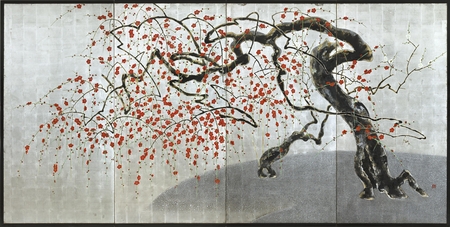Product Description
7487 Kawasaki Shozo (date unknown)
A four-fold paper screen painted in lacquer and colour on a silver ground with two gnarled ume (plum trees) in full bloom. The foreground is dominated by the larger of the two trees which has red blossom while the smaller tree in the background has white. Both trees sit atop a knoll in a Japanese rock garden rendered in moriage (raised design).
Seal: Shō
Japan 20th century Taishō period
Dimensions: H. 74″ x W. 146″ (187.5cm x 370.5cm)
In Japan plum blossoms is celebrated as a harbinger of spring due to it blooming towards the end of January. The blooms appear when there is still snow on the ground, and are considered a symbol of strength and overcoming adversity. It is also known as one of the shōchikubai (lit. pine-bamboo-plum) or saikansanyū (lit. three friends of winter) since the beginning of the 13th century. The plum also symbolises longevity as the blossoms continue to appear on old gnarled branches of ancient plum trees, their sweet fragrance improving with age.
Paintings of blossoming plum offer artists excellent opportunities to demonstrate the calligraphic flair of their brushwork. Since plum blossoms have multiple connotations in Chinese and Japanese cultures their representation offers numerous possibilities of symbolic expression. As one of the earliest spring-flowering trees, plum symbolises rejuvenation and vitality. Because the tree is hardy and often long lived, its branches also signify endurance and perseverance. In other contexts, the delicate white blossoms were often associated with purity and feminine gracefulness. With so many possible meanings, paintings of plum blossom could be displayed on many occasions, a versatility that was no doubt part of the genre’s long-lasting appeal.
It would seem likely that the pairing of red and white as seen in this iconic imagery has its roots in the Gempei war between the Taira and Minamoto clans at the end of the 12th century, with the victorious Minamoto founding the Kamakura period (1185-1333). This war and its aftermath established red and white, the respective colours of the Taira and Minamoto, as Japan’s national colours. Today, this combination of colours can be seen in sumo competitions, various traditional activities and on the national flag of Japan.
Note: the back of the screen bears two exhibition labels which read:
Lower label: Ume, Kawasaki Shōzō (Plum, Kawasaki Shōzō)
Upper label: Daimei; ume. Meishi; Kawasaki Shōzō. Dai; ni jyūni gō (Title; plum. Name; Kawasaki Shōzō. No. 22)










